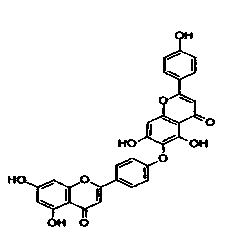Method for extracting hinokiflavone from Cacumen Biotae
A technology of cypress biflavonoids and cypress leaves, applied in the biological field, can solve the problems of large amount of reagents, complicated purification process, and difficulty in industrial production
- Summary
- Abstract
- Description
- Claims
- Application Information
AI Technical Summary
Problems solved by technology
Method used
Image
Examples
Embodiment 1
[0018] Take 20kg of Arborvitae leaves and add 10 times the amount of saturated lime water to soak and extract twice. The extract is filtered and ultrafiltered with a hollow cellulose membrane with a molecular weight cut off of 3000. The permeate is then concentrated with a hollow cellulose membrane with a molecular weight cut off of 500. Adjust the pH of the solution to 5 and add it to the D101 macroporous resin column for adsorption. First, take 5 times the column volume of 20% ethanol solution to elute the impurities, and then use 10 times the column volume of 50% ethanol to elute the active ingredients. The eluent is concentrated to adjust the ph3 crystallization. Filter out the crystals and dissolve them with 80% methanol under reflux, concentrate until the alcohol concentration reaches 10%, add to D101 macroporous resin column for adsorption, first take 5 times column volume of 30% ethanol solution to elute impurities, and then wash with 7 times column volume 60% ethanol T...
Embodiment 2
[0020] Take 20kg of Arborvitae leaves and add 5 times the amount of saturated lime water to soak and extract for 3 times. The extract is filtered and ultrafiltered with a hollow cellulose membrane with a molecular weight cut off of 6000. The permeate is then concentrated with a hollow cellulose membrane with a molecular weight cut off of 400. Adjust the pH of the solution to 5 and add it to the AB-8 macroporous resin column for adsorption. First, take 6 times the column volume of 30% ethanol solution to elute the impurities, and then use 7 times the column volume of 60% ethanol to elute the active ingredients. The eluent is concentrated to adjust the pH4 crystallization. Filter out the crystals and dissolve them with 50% methanol under reflux, concentrate until the alcohol concentration reaches 20%, add to the AB-8 macroporous resin column for adsorption, first take 10 times the column volume of 20% ethanol solution to elute impurities, and then use 7 times the column volume of...
Embodiment 3
[0022] Take 20kg of Arborvitae leaves and add 5 times the amount of saturated lime water to soak and extract for 3 times. The extract is filtered and ultrafiltered with a hollow cellulose membrane with a molecular weight cut off of 6000. The permeate is then concentrated with a hollow cellulose membrane with a molecular weight cut off of 400. Adjust the pH of the solution to 5 and add it to the HZ816 macroporous resin column for adsorption. First, take 6 times the column volume of 30% ethanol solution to elute the impurities, and then use 7 times the column volume of 60% ethanol to elute the active ingredients. The eluent is concentrated to adjust the pH4 crystallization. Filter out the crystals and dissolve them with 50% methanol under reflux, concentrate until the alcohol concentration reaches 10%, add to the HZ816 macroporous resin column for adsorption, first take 6 times the column volume of 20% ethanol solution to elute impurities, and then wash with 7 times the column vol...
PUM
 Login to View More
Login to View More Abstract
Description
Claims
Application Information
 Login to View More
Login to View More - R&D
- Intellectual Property
- Life Sciences
- Materials
- Tech Scout
- Unparalleled Data Quality
- Higher Quality Content
- 60% Fewer Hallucinations
Browse by: Latest US Patents, China's latest patents, Technical Efficacy Thesaurus, Application Domain, Technology Topic, Popular Technical Reports.
© 2025 PatSnap. All rights reserved.Legal|Privacy policy|Modern Slavery Act Transparency Statement|Sitemap|About US| Contact US: help@patsnap.com

